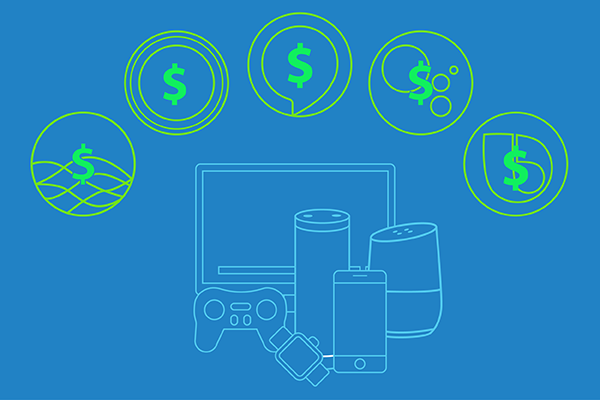Juniper Forecasts $80 Billion in Voice Commerce in 2023, or $10 Per Assistant

Much of the focus around the new Juniper forecast last week centered on the projection of eight billion voice assistants in use by 2023. However, toward the end of Juniper’s announcement and therefore at the end of the articles’ that mentioned it, was a prediction about voice commerce. Juniper estimates that voice commerce in 2023 will rise to $80 billion. We like math at Voicebot and after running multiple excel models we concluded this came out to just $10 in voice commerce transactions per assistant annually.
Voice Commerce Value of a Device and User by Region
Juniper confirmed with Voicebot that a smartphone with three different voice assistants in use but owned by a single user is three voice assistants in its calculations. This means you can’t equate voice assistants with users. Given the rise in smartphone and smart device ownership, you can expect each user to average at least two voice assistants so you might be considering somewhere between 3.5 and 4.0 billion users. It is tempting to say this would be $20 annually per user, but this will vary widely by country.
If we use Facebook’s global revenue per user by region as a benchmark, we can see the relative over and under-indexing by region compared to the average. An average of $20 in voice commerce transactions per user annually on a global basis might yield $94.60 in the U.S. and Canada, $29.80 in Europe, and $8.03 in Asia. The U.S. and Canada number is not too far below an annual Spotify subscription, but Europe would be well below that mark.
Using a benchmark such as online shopping per capita may be a better guide and significantly compresses these differences with U.S. and Canada users yielding $22.21 in annual voice commerce transactions while Europe is $21.26 and Asia $16.52. However, online shopping is mature and voice commerce is not. It may be that the U.S. and China, in particular, will have overweighted indexes in terms of voice shopping than other nations for the next several years simply due to earlier adoption of voice assistants. Regardless, when you consider voice commerce along with other revenue streams such as advertising, you start to get a sense of where voice assistants can generate revenue when they reach mass adoption.
Comparing Juniper to Other Voice Commerce Forecasts
Just about one-year ago OC&C Strategy, a U.K.-based consultancy forecasted that voice commerce would reach $40 billion in the U.S. alone in 2022. If the U.S. is overweighted in voice commerce this may align well with the Juniper forecast. The OC&C study estimates that 2017 voice commerce totaled only $2 billion in the U.S. and U.K. in 2017 so there is a long way to go before we can count on a number like $40 billion in the U.S. or $80 billion worldwide. However, it is worth noting that recent forecasts related to voice adoption have consistently had one thing in common: severe underestimation. Tepid adoption today may well yield to a new consumer habit. Juniper points out in a white paper this month that integration of voice with visual elements through smart displays and smart TVs could be just the catalyst required for voice shopping to start growing quickly.
Follow @bretkinsella Follow @voicebotai
Over 1 in 5 Consumers Have Tried Voice Shopping and Most of it Was on Mobile
Juniper Estimates 3.25 Billion Voice Assistants Are in Use Today, Google Has About 30% of Them
Voice Shopping to Reach $40 Billion in U.S. and $5 Billion in UK by 2022








